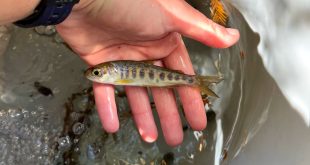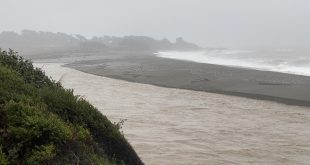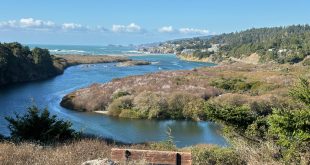Family: PINACEAE
In many countries around the world, an evergreen tree is the symbol of the yule tide season, representing the spirit of hope in the deepest dark of winter. Among the species of conifers chosen as Christmas trees, grand fir stands out. Its lustrous dark green needles, citrus-like fragrance, and beautiful conical shape lend it an elegance that few other species can match.
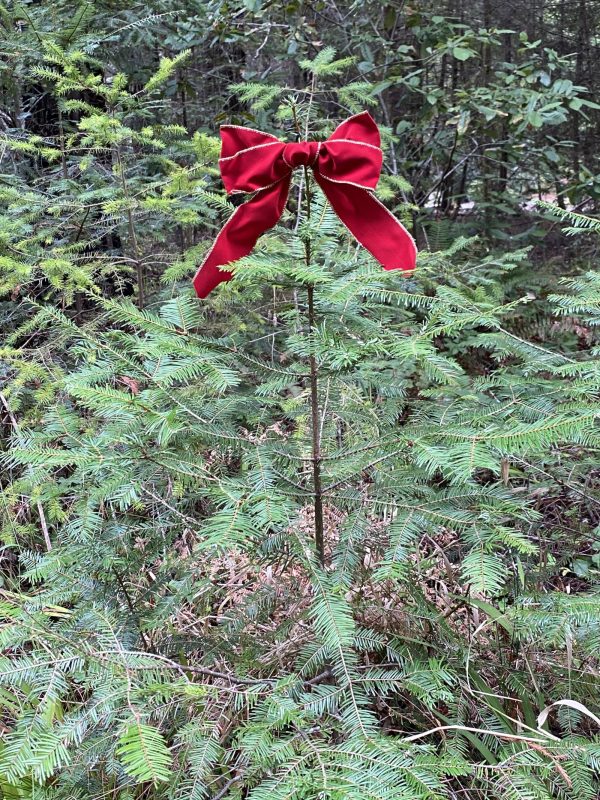
Here in the Gualala River watershed, you don’t have to go to a commercial tree lot to see grand firs. They are native to our area. [Photo 1.] While saplings are the appropriate size for Christmas trees, grand fir gets its name from the fact that it is the tallest of the firs along the Pacific coast, reaching over 250 feet in height, though in our watershed it is of more modest stature. The National Registry of Champion Trees compiled by American Forests lists a grand fir in Humboldt County as 257 feet tall, over 21 feet in circumference with a crown spread of 36 feet!
Like Western hemlock, grand fir is at its southernmost range extension here where lower rainfall and humidity relative to the rest of its range to the north limit its growth. The species grows from Sonoma County along the Pacific coast, to Oregon and Washington where it ranges inland, to British Columbia. A separate subspecies grows in the Rockies in Idaho and Montana.
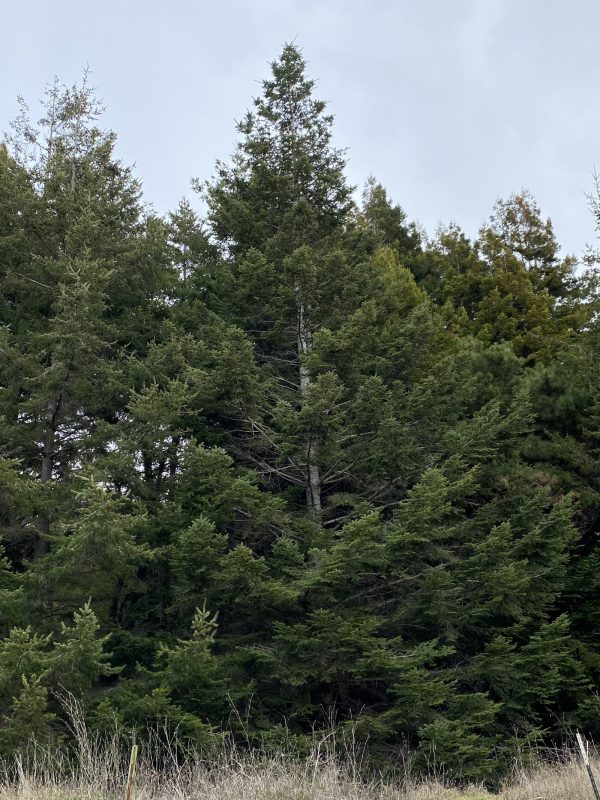
Locally, grand fir grows most frequently within ten miles of the coast in the company of redwoods and Douglas fir (which is not a true fir) in mixed conifer forests that occur from sea level up to ridge tops. [Photo 2.] It’s sometimes difficult to distinguish grand fir from these trees when they are growing together. Here are some good field characteristics for observations from different distances.
Field Characteristics for Identification
Examine the glossy dark green needles up close. The needles are notched at the tip, have a central groove, and are horizontally spread in two distinct rows. [Photo 3.] From above you can see that the needles are two different lengths with the upper row slightly shorter than the lower. [Photo 4.]
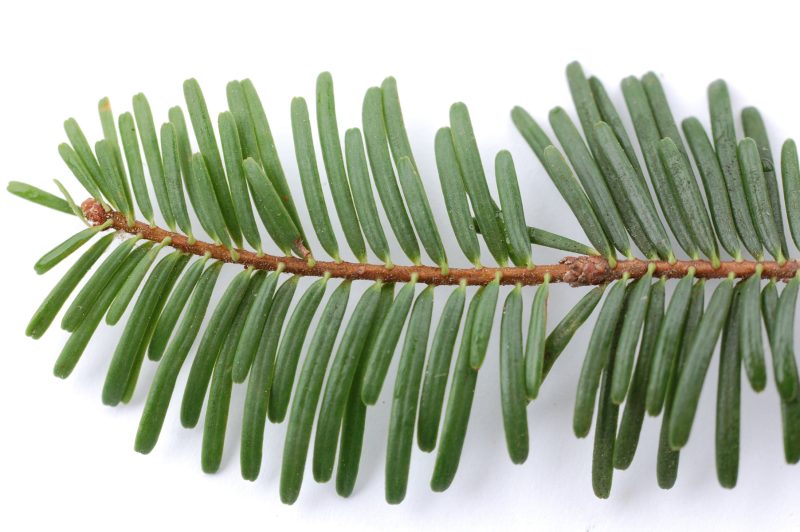

Notice how the needles twist at their base just before their attachment to the branch. From the side, you can see how the needles splay out in a flat plane. [Photo 5.] White stomatal lines appear along the undersides. [Photo 6.]


Stomata are pores in the needles through which gases like oxygen, carbon dioxide, and water vapor are exchanged. Look at the photos of the upper and under sides of the needles from 5 different conifers that grow here in our watershed. [Photos 7. and 8.] Can you pick out the grand fir?
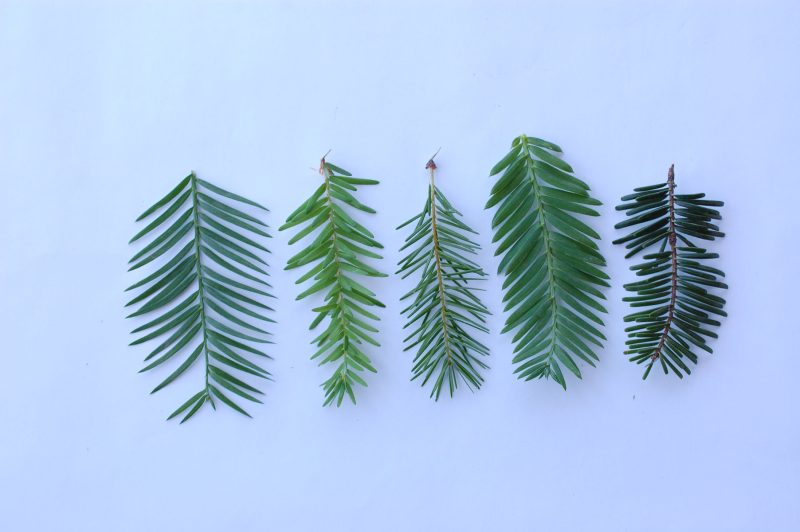
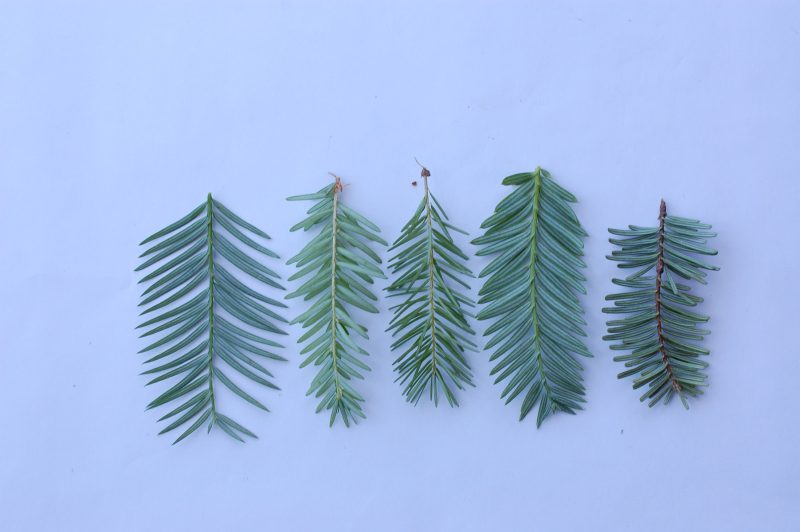
If you’ve been handling the needles, by now you have caught their powerful fragrance. The common name, stinking fir, does not refer to the odor of the needles but to the cut wood which apparently smelled unpleasant to loggers, but was reputed to ward off insect pests.
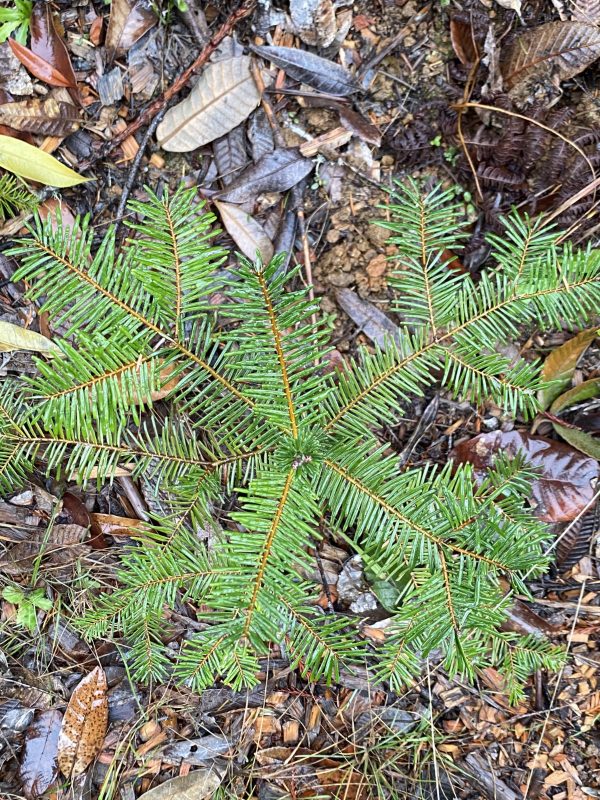
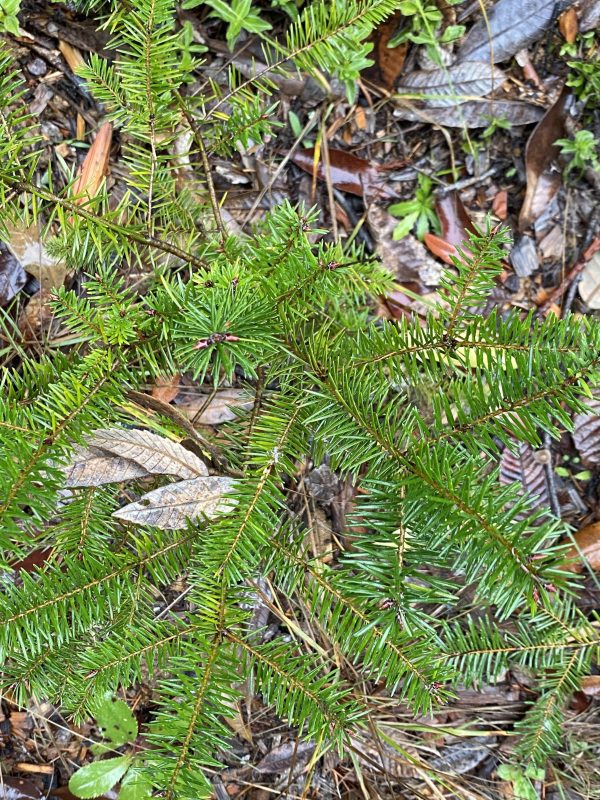
If you’ve found a very young tree such as the one in the photo, position yourself above it and observe how the straight, sturdy branches emerge from the trunk. [Photo 9.] Compare the photo of the young grand fir with that of the Douglas fir about the same age and notice how much more narrow, spindly, and irregular the branches are in the Douglas fir. [Photo 10.] These early branches will provide support for the secondary branches and the foliage. The grand fir produces stronger branches and gives the tree an overall stiff appearance like the tutu of a ballerina. The branches also produce greater symmetry, beauty, and resistance to breaking—one reason that you won’t find many grand fir branches broken and lying on the ground as you do with Douglas fir. Nonetheless, mature Douglas fir wood is stronger and much more economically valuable as lumber.
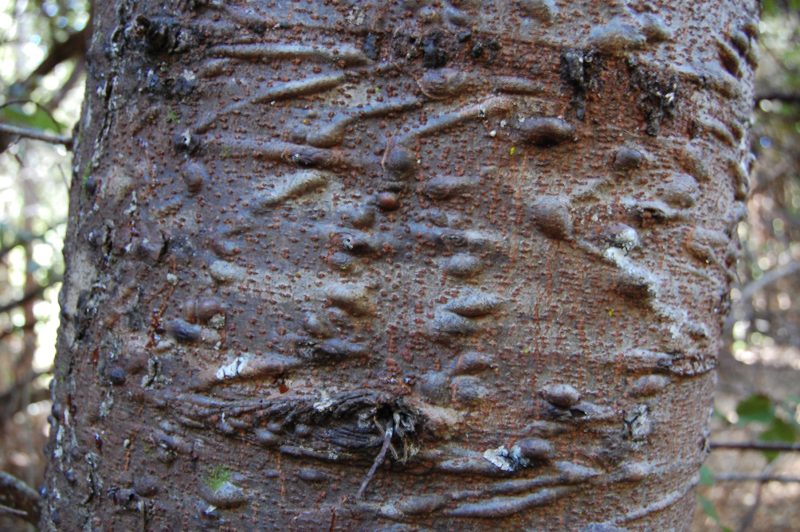
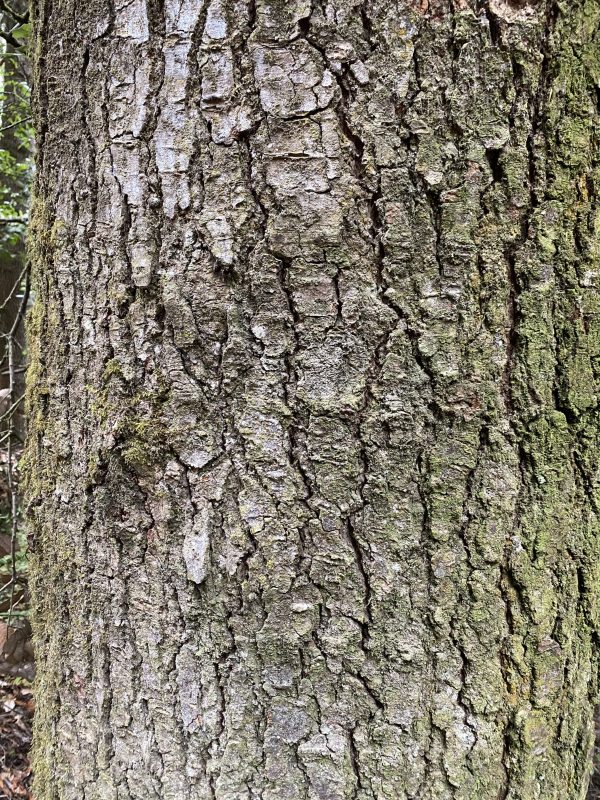
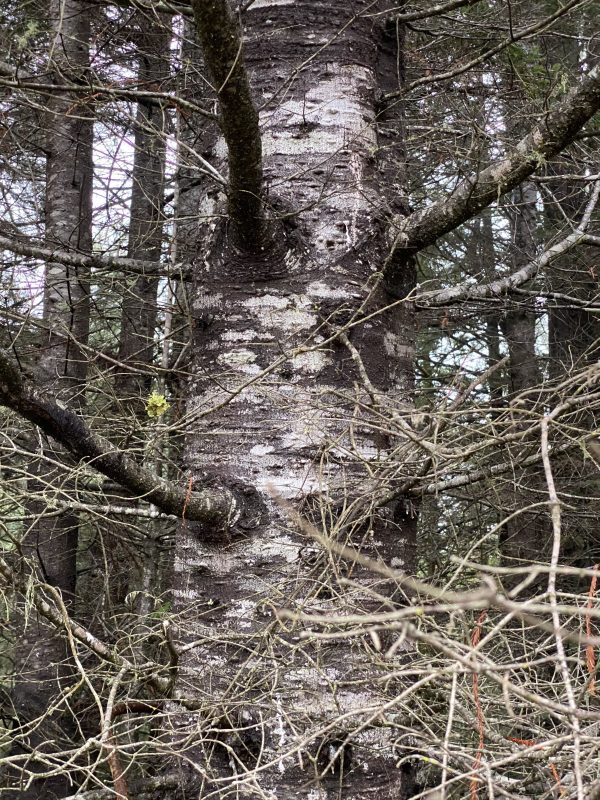
You can complete your close up observation by inspecting the bark which is fairly smooth and thin in young trees but pocked with resin blisters that can pop and squirt or leak long lines of pitch. [Photo 11.] As the tree ages, the bark thickens into blocks and is often marked by white patches and horizontal ridges. [Photo 12.]
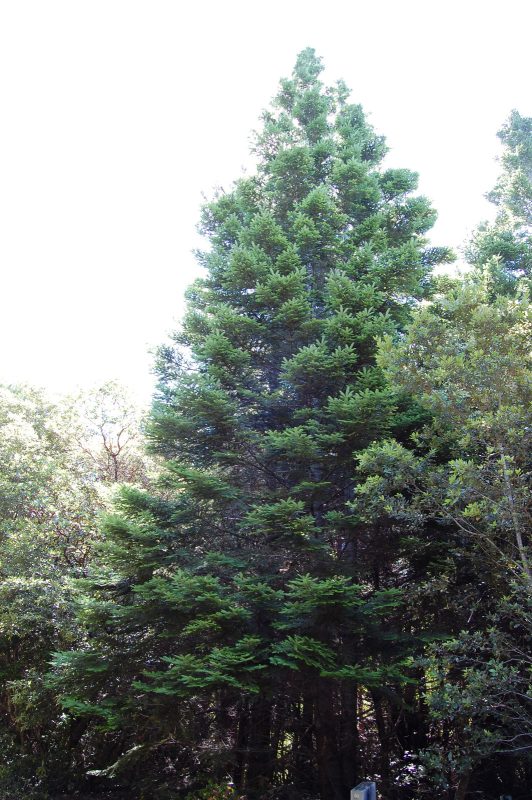
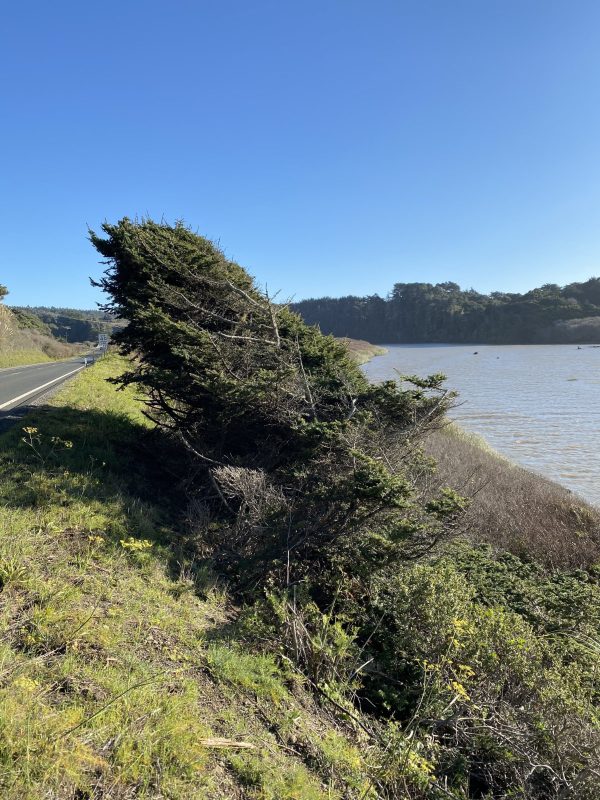
Find more mature trees and from a distance note their shape. In the ideal growing conditions of abundant light and sufficient moisture, grand fir assumes a lovely conical shape. [Photo 13.] The trunk grows very straight. Sometimes the crown may be rounded in age or the leader may be crooked and bare, shaped by persistent wind. Grand firs can tolerate extreme conditions such as salt air and high winds like those found along our estuary, and there the firs become wind-pruned and stooped Krumholz trees resembling nothing like their erect forest-dwelling kin. [Photo 14.]
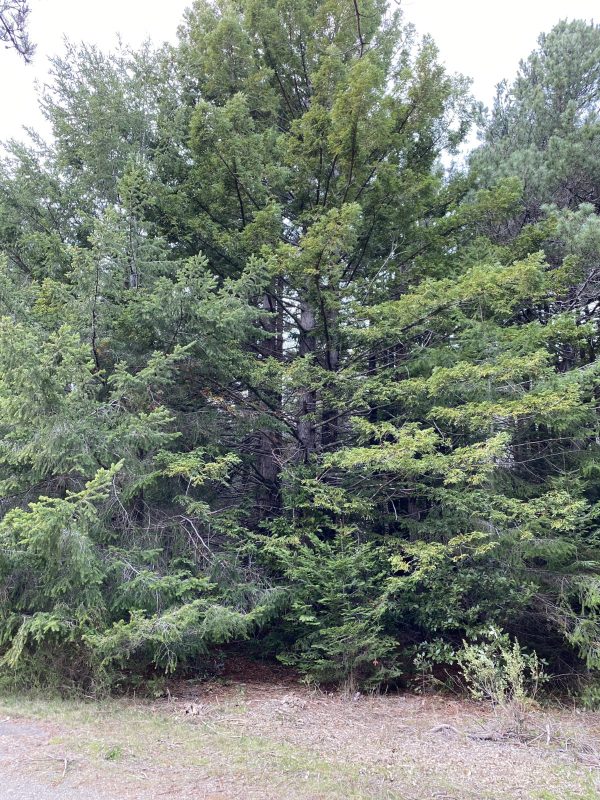
Now that you know what grand fir looks like, can you find it in this photo among other conifer species? [Photo 15.]
Reproduction
Grand firs become reproductively mature around 20 years or so. They are monoecious, meaning that both male and female flowers occur on the same tree. Female flowers, which will produce cones and seeds, are borne on the crown of the tree, while male flowers which contain the pollen, hang on branches below the female flowers. We have no photos of the small flowers to show you because flowering takes place in the tops of tall trees!
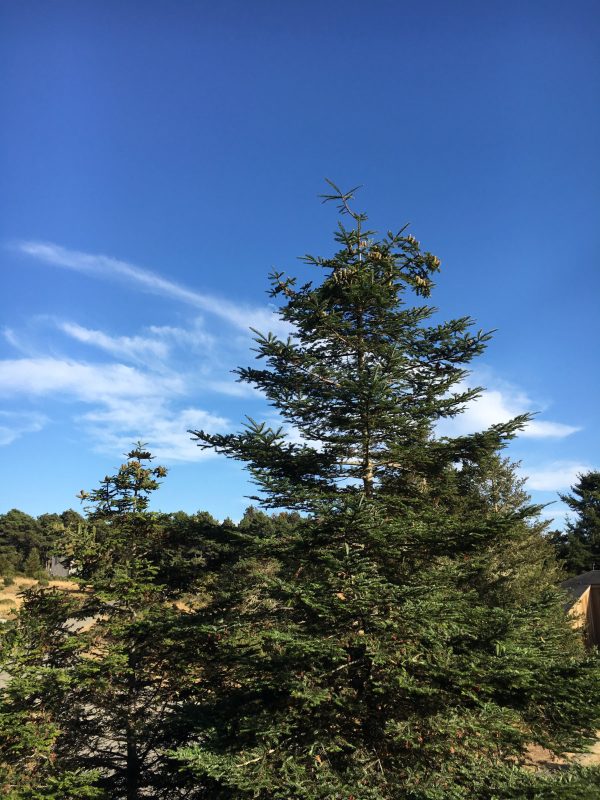
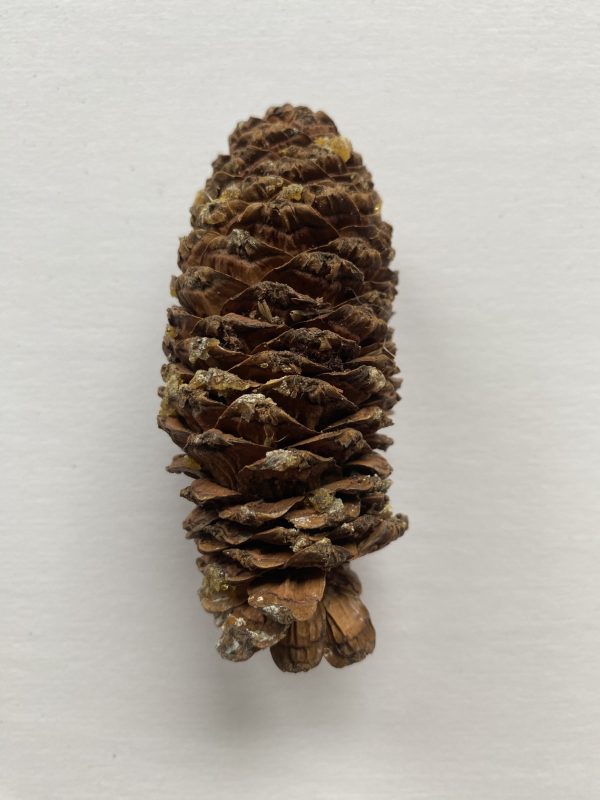
In spring the female flowers are pollinated by the wind. Cones develop on the tops of the branches throughout the summer and ripen in August and September. [Photo 16.] The cylindrical cones are 2-4 inches tall and yellowish green, later becoming tawny or purplish. [Photo 17.]
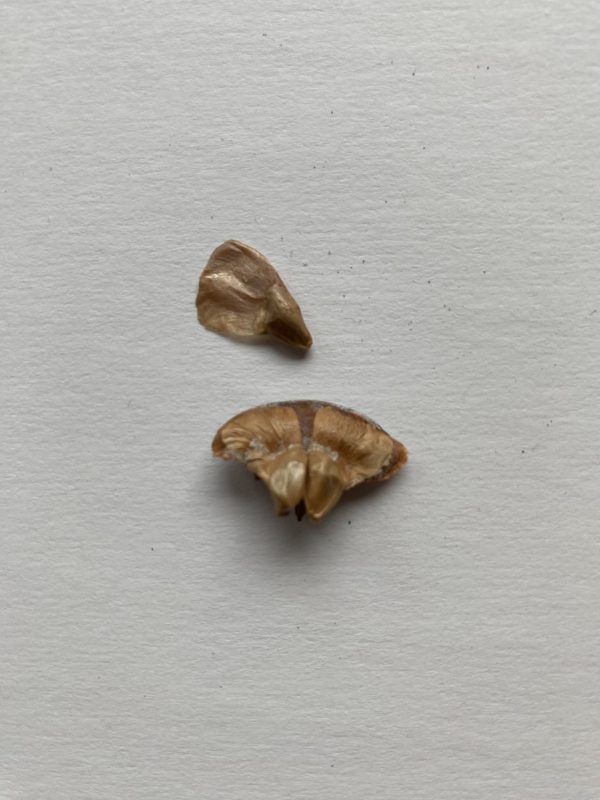
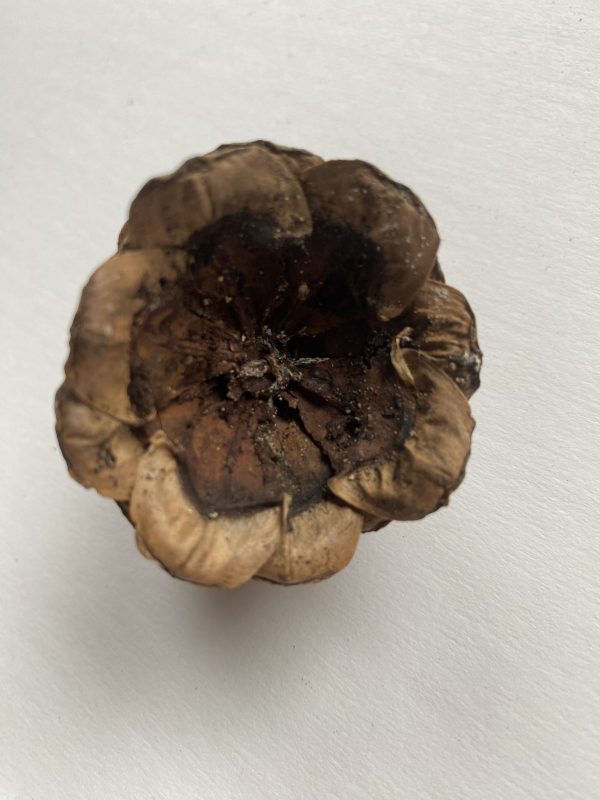
The cones are formed by scales radiating around a central spire. Within the cones, the winged seeds form, two atop each scale, side by side. [Photos 18. and 19.] Seeds are dispersed by the wind and gravity in the fall as the cones naturally disintegrate or are torn apart by foraging squirrels and birds. It’s unusual to find intact cones on the ground, but the forest floor beneath the trees is often heavily littered with cone scales. [Photo 20.]
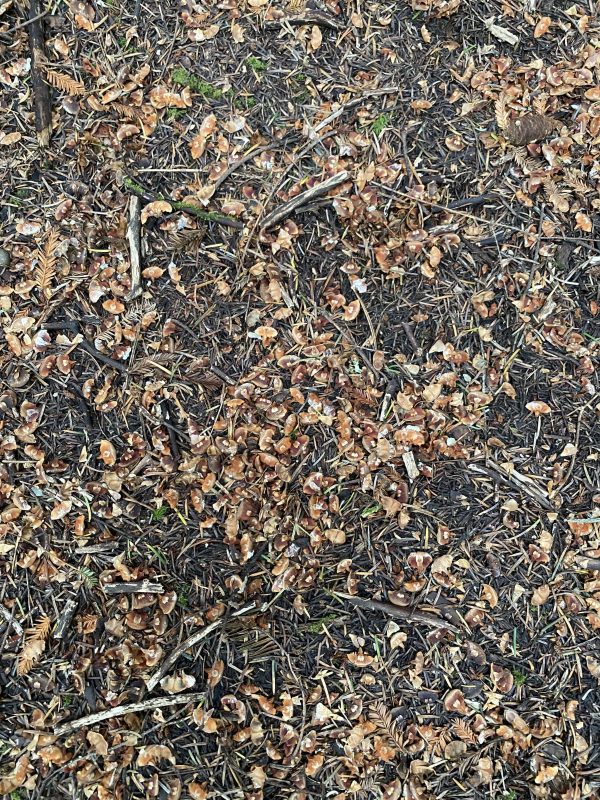
Growth Cycles, Circulation, and a Hat Trick
Trees grow in two directions throughout their life span. They grow up and they grow out. Here’s a brief video that illustrates daily growth of a Douglas fir which would be similar to that of a grand fir. As you can see from the video, the part of the tree responsible for this growth is the cambium, a very thin layer of undifferentiated cells, close to the inside of the bark that can produce more specialized cells. The cells it produces on its outer side (toward the bark) become phloem composed of sieve cells which are vertical tubes that transport sugars and carbon down from the photosynthesizing canopy to the roots. Sieve cells can also transport water in both directions. On its inner side the cambium produces xylem composed of sturdier vertical tubes (tracheids) which transport water and nutrients up from the roots to the canopy. This, then, is the functional circulatory system of the tree, moving fluids, nutrients, sugars, carbon, and signaling chemicals throughout the tree. This one-page guide with a diagram from the Arbor Day Foundation illustrates and defines the different parts of a tree. [Photo 21a]
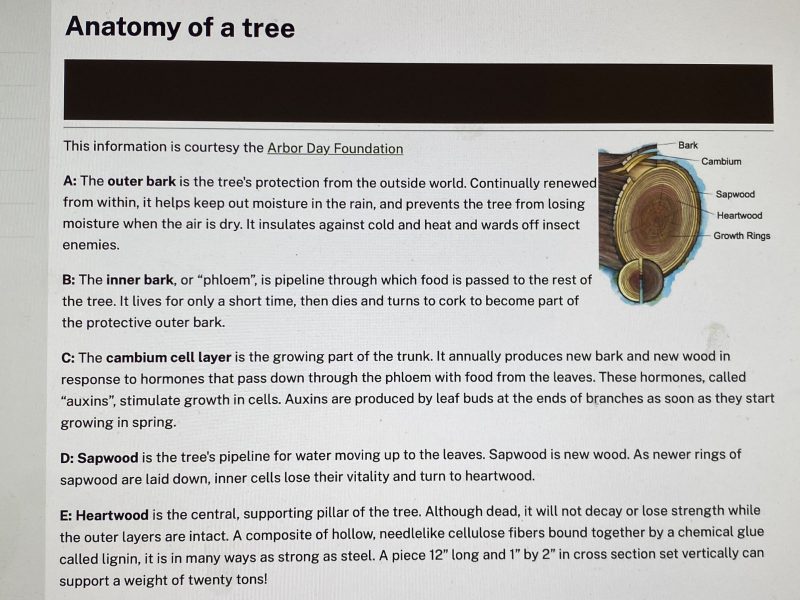
As an aside, consider for a moment the physical challenge trees face in raising the weight of fluids dozens of feet (or hundreds of feet, in the case of large species like grand fir or old growth trees) above the ground against gravity. With no pump or analogue to a heart, trees must create and maintain a powerful internal hydraulic system. Until recently, it was supposed that this system depended wholly upon the cohesive force of water drawn up from the roots via capillary action in the tracheids while water transpired through the tips of leaves or needles. This continuous flow is critical to effective fluid transport. If something should break that tension—say, an air bubble, a loss of water due to drought, freezing, or salt—an embolism results in cavitation or collapse. With climate change and a re-focusing on forests, scientists have begun to look more closely at tree hydraulics, and it appears that they are far more complicated than originally surmised. As soil moisture declines, forest trees—and especially very large trees like grand fir—may no longer be able to maintain their hydraulic integrity. That they have evolved internal mechanisms to allow them to reach over 350 feet of height—as in the case of coast redwoods—is nothing short of miraculous.
But the tree’s circulatory system has yet another amazing dimension. It also doubles as the tree’s structural support system. That is, the tracheids in the xylem die, but they retain their structural integrity. How do they manage that? In one of evolutions’s giant leaps, green plants developed a substance that is strong but flexible, that imparts longevity and the capacity to grow very large and very tall, that is resistant to many diseases and insects, that enables trees to spread out across the planet in huge forests and inhabit many different habitats. That substance is lignin, the dominant polymer in wood.
It’s a truism that wood helped humankind build civilizations: houses, paper, books, tools, fuel—its uses are nearly endless. Cut a tree and make something out of wood. Only recently have we begun to recognize one of wood’s most important roles in the life of the planet—its ability to store carbon and help regulate our atmospheric carbon dioxide. Wood left in a growing tree is one of the best means to grow our ability to sequester carbon. Leave a forest and cool the planet.
The Formation of Wood
The formation of wood is best revealed in cross sections of a tree trunk. In addition to daily growth cycles, all tree species have seasonal growth cycles as well. In this photo of a grand fir round, you can read the tree’s history. [Photo 21b.]
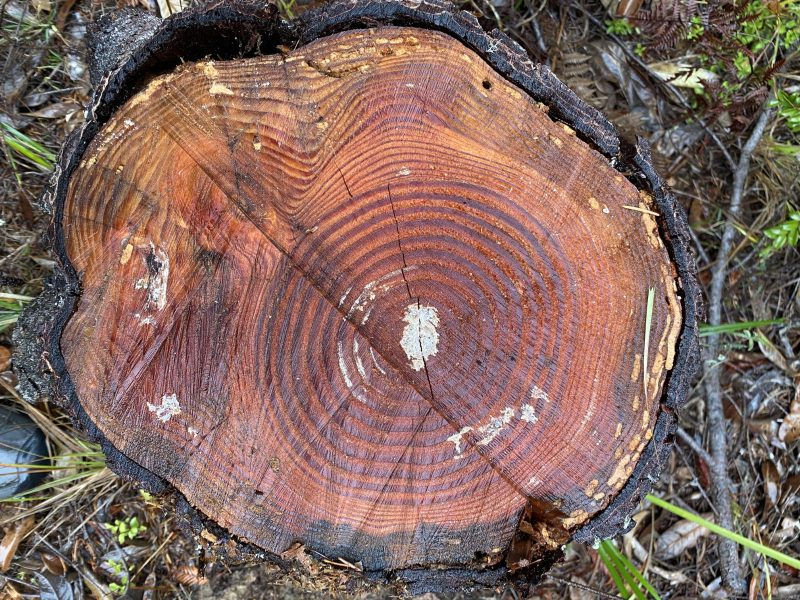
The well-defined series of rings composed of pairs of alternating wider light rings and thinner dark rings shows us how the tree responds to seasonal changes. In spring and summer—the growing season— when temperatures rise and there is more available light, the energy cycle of the tree increases. Water and nutrients are drawn up from the roots into the canopy to help fuel and support photosynthesis in the needles. The growth of tracheids in the xylem to accommodate this transport results in the wide, light-colored ring called earlywood. In fall, as the growing season winds down, structural support and carbon storage become important. In response to lower light and falling temperatures, the tree produces smaller but thicker-walled tracheids forming thinner dark rings which are called latewood.
Each pair of light and dark rings reveals that year’s growth, and in years when growing conditions are optimal, the rings are broad. In years when the trees are stressed as by drought, the rings are thin. As the tree grows in girth, the outer rings get thinner and more closely spaced. This record of growth is used by dendrochronologists to learn about climate change over time. Counting the tree rings tells us how long the tree lived as well as what environmental conditions it experienced over its lifetime. The round in the photo was cut quickly with a chain saw, and the cut is not particularly clean, but it’s still possible to count some of the annual rings. What can you tell from the patterns about the life history of this tree?
Ecology: animal, fungal, epiphytic associates; pests; wildfire
Background
A tree’s ecology is its relationship with its environment which includes both living organisms and abiotic elements like soil, climate, and fire. Like the ecology of Western hemlock, the ecology of grand fir here at the very southernmost end of its range has not received much attention, in part because it plays no economic role for the timber industry the way it does farther north in the heart of its range. While the species itself is not rare, the California Native Plant Society and NatureServe rank the Grand Fir Alliance—which is the vegetation community in which it is the dominant species—S2.1, which translates as rare and seriously threatened at the state level. It’s important to remember that when we look at the grand firs here in the watershed, we are looking at trees growing in extreme and limiting conditions for the species.
For a moment, let’s set the broader context for considering how different environmental conditions are here in our watershed as compared with the heart of the grand fir distribution range farther north. Locally, our annual rainfall averages between 36 inches at Gualala and 48 inches in Annapolis with little to no rain falling between May and September—our summer dry period—and no snow accumulating in the higher elevations of our watershed. At the northernmost coastal portions of the range in British Columbia, average annual rainfall can top 100 inches. In the Olympic National Park in Washington, rainfall can exceed 130” inches a year, and rain can occur reliably throughout the year in any month. In the winter, snow in the Olympic Mountains at 3000 feet provides late winter and early spring snow melt which fills the creeks and rivers and is another important source of soil moisture. That means that soil moisture is continuously higher there than it is here during key portions of the growing season. And, summer daylight hours at our latitude of 38 degrees north are not as long as at 50 degrees north in British Columbia. All of these factors together make for grander grand firs than we have here.
Key Associates
Here in the Gualala River watershed grand fir is an occasional tree of mixed conifer and mixed conifer/hardwood forests, occurring most abundantly along the bottom lands near the coast. While grand fir does not play the dominant role that coast redwoods and Douglas fir play, it factors into the ecology of the forests in which it grows. Grand firs that are logged do not re-sprout, so the continuing survival of the species is dependent upon abundant seed production and germination. Grand fir seeds provide a rich food source for birds and small mammals such as squirrels. Its snags are a good source of insects for forest-dwelling birds such as woodpeckers, chickadees, and nuthatches and provide cavities for nesting. [Photo 22.]
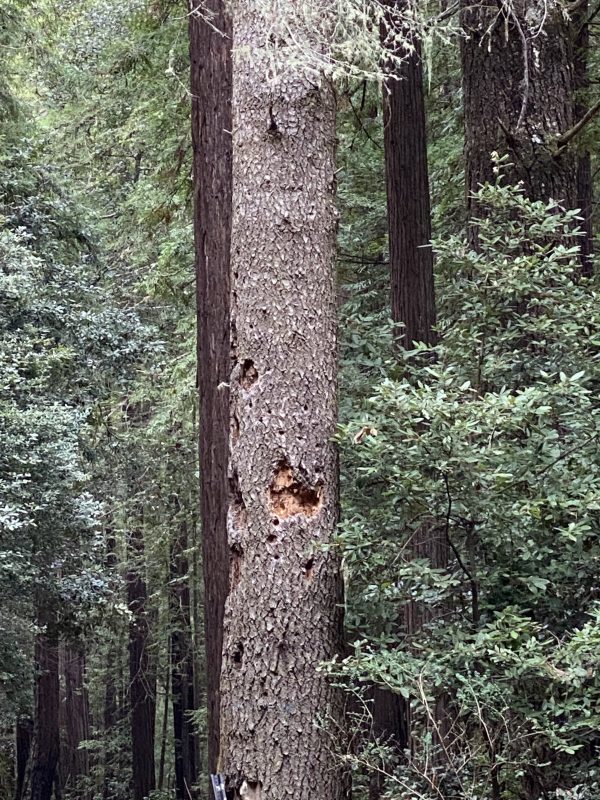
When co-occurring redwoods are logged off, grand firs that have grown in their shade often are released to become more dominant with less competition and more light. The trees that have grown up in the dense shade of redwoods, however, do not have the same vigor that those growing in the open achieve.
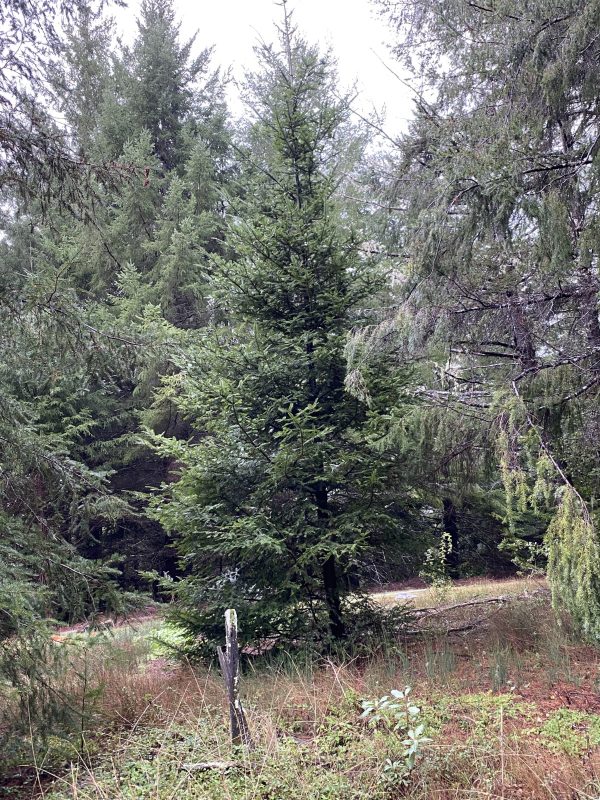
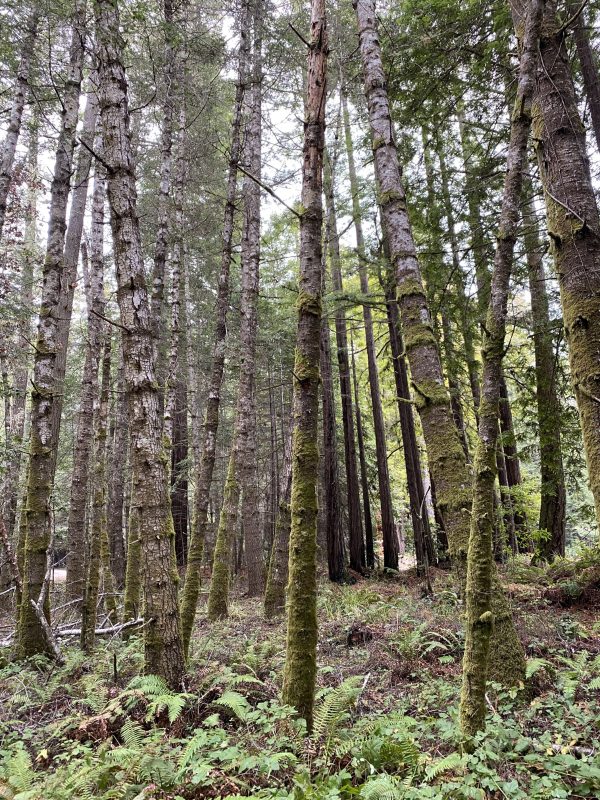
Compare this tree in a meadow [Photo 23.] with those that grew up beneath a redwood canopy. [Photo 24.] In terms of its understory, there are no native plant species associates specific to grand fir here. Instead the understory is likely to be that of its co-occurring tree species whether coast redwood or Douglas fir.
Another key ecological factor in the health of forest trees like grand fir is the presence of ectomycorrhizal associates in the soil. These are fungi that provide nutrients and water to the roots of the trees in exchange for the sugars that trees make through photosynthesis in a reciprocally beneficial relationship. The fungi form complex filamentous networks called mycelia that connect trees with one another and are an essential element in the powerful, hidden underworld of the forest. Their fruiting bodies are most notably mushrooms but other fungal forms can be ectomycorrhizal in nature also.
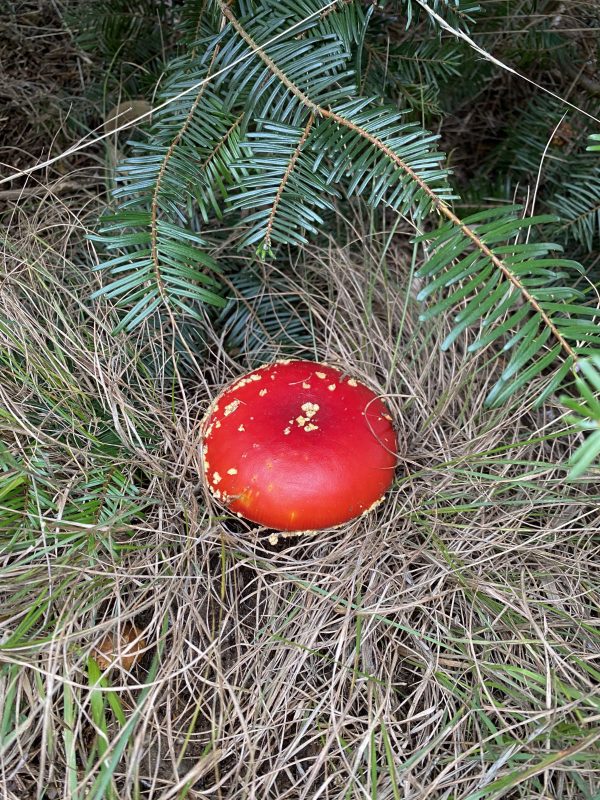
Mycologists who are experts in the redwood coast fungi (Arora, 1986; Siegel and Schwarz, 2016) mention grand fir associates such as certain species of Cortinarius, boletes, and fir lion’s mane (Hericium abietis), but they report that these species don’t occur along our section of coast. Instead they grow with grand fir along the far Northern California coast or in the mountains, yet another indication of the different environment in which our local grand firs grow. Here grand fir are more likely to connect with more common and general mycorrhizal associates of conifers like the fly agaric, Amanita muscaria, a native of Eurasia. [Photo 25.]
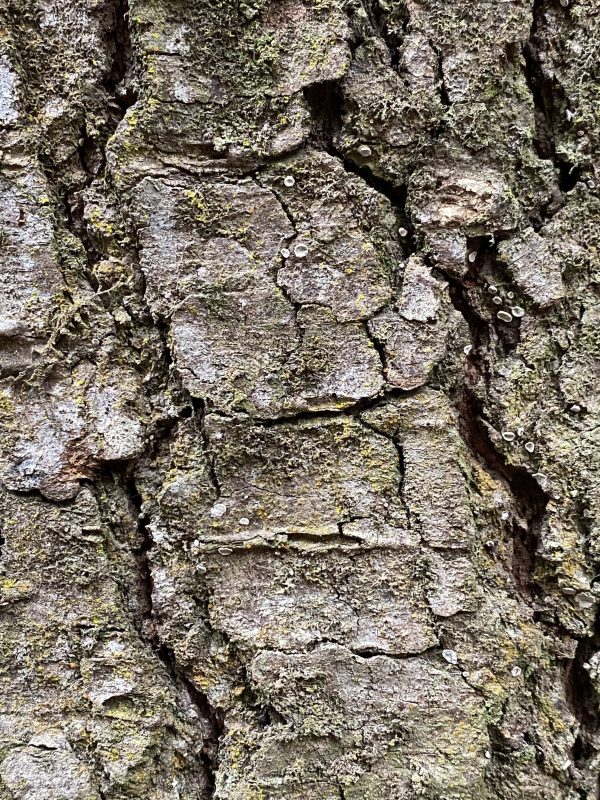
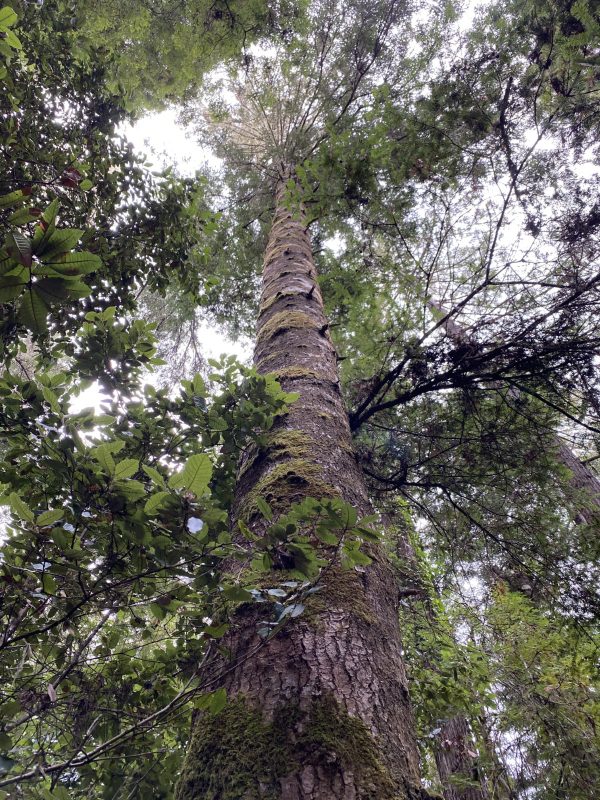
As trees of shaded, moist sites, grand firs host an epiphytic community of mosses, liverworts, lichens, and fungi, [Photos 26. and 27.] though not as abundant and species-rich as one might expect. Grand firs in forests near the coast are often festooned with the pale green of Usnea species of lichens. [Photo 28.]
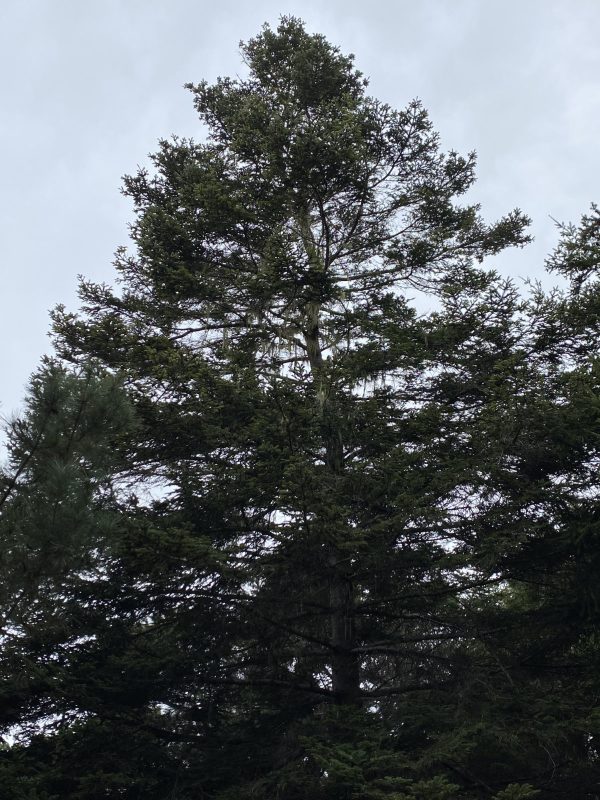
Threats
Young grand firs are not adapted to wildfire. Their thin bark causes them to burn easily. But as grand firs age, their bark thickens and becomes much more fire resistant, though fire damage can often lead to insect invasions and fungal infections. When wildfire has killed off trees but there are remaining grand firs of reproductive age, their seed production can result in rapid re-population of grand firs. Here in the Gualala River watershed, grand firs are at relatively lower risk for wildfire as they are associated with the more mesic areas where wildfire is not as great a threat.
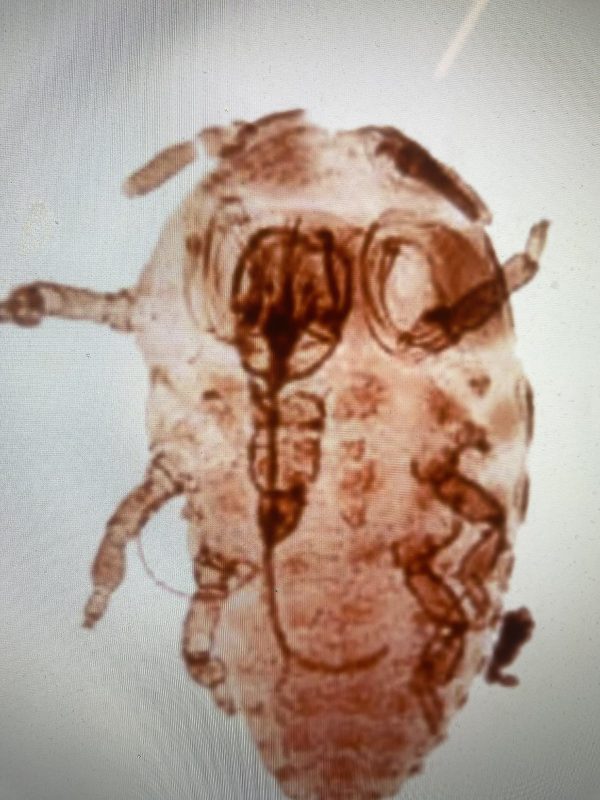
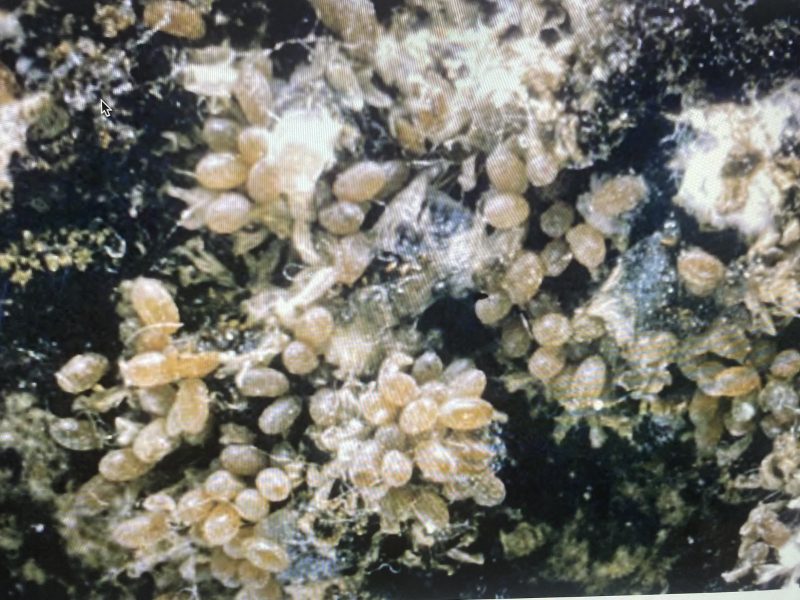
More recent attention is being paid to grand fir regarding its role in hosting the balsam woolly adelgid, Adelges piceae, an insect pest from Europe that attacks and damages fir species. It feeds by inserting a long tubelike structure into the plant tissue to suck up sap, weakening the tree, damaging the foliage, and sometimes killing the tree. [Photos 29. and 30]
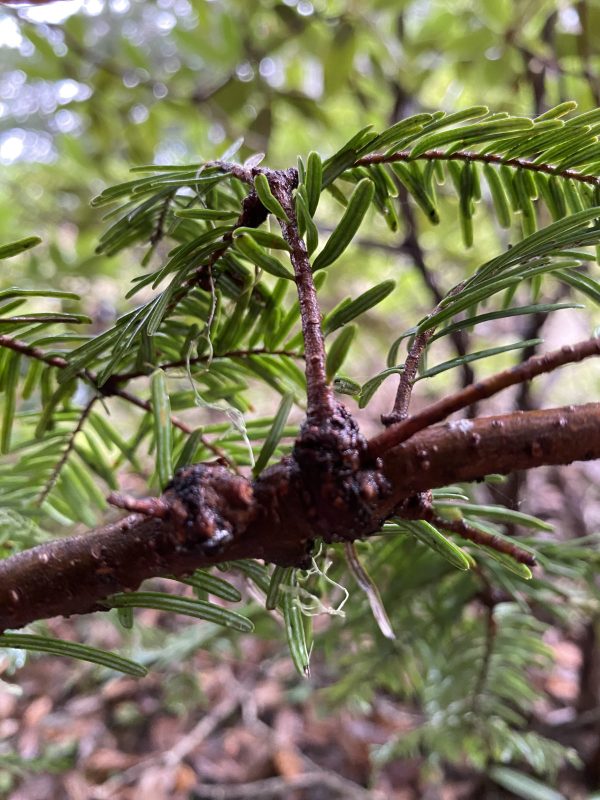
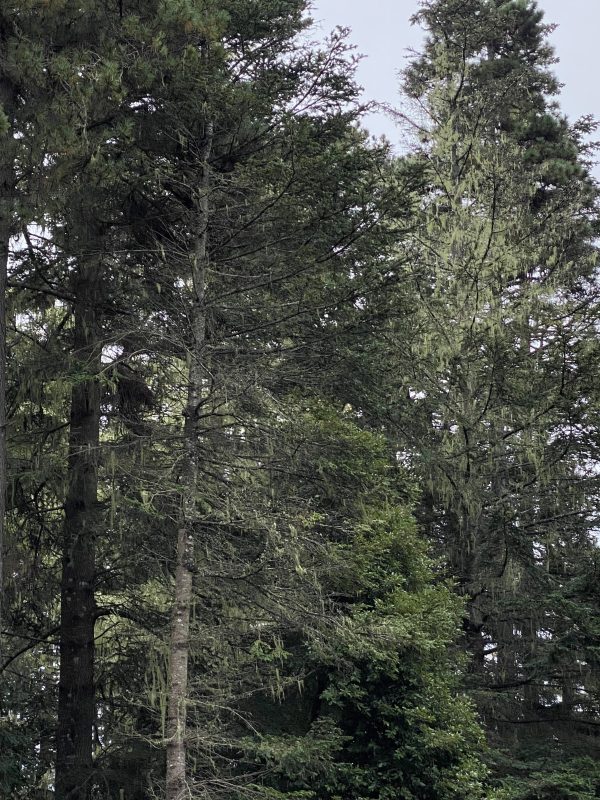
Adelgids also inject substances into the sap that that cause the tree to form swollen, knobby areas at nodes and tips of infested branches—a condition called gout. [Photo 31.] This pest has been responsible for the catastrophic loss of hemlocks and firs on both the east and west coasts. It has been detected here in our watershed —trees infested with the pest can be seen along Church Street– its status has not been closely tracked. [Photo 32.]
The future of grand fir in our watershed is an uncertain one. Whether it can persist as the climate continues to warm and dry is unknown. In 1948, Donald Culross Peattie wrote of the grand or lowland fir in his classic A Natural History of North American Trees: “The wood is too soft, yet too heavy in proportion to its little strength, to make first-class lumber. Pulpwood offers its only commercial future and there are so many finer pulping species in the woods that Lowland Fir is little felled for any purpose and is usually left in the forest to make music and distill incense.” Nearly 75 years later, when our forests are being decimated despite their immense value to the well-being of the planet, we can say that grand fir may have a more important purpose than monetary, whether it’s the contribution it makes to carbon sequestration, to biodiversity, or, like Western hemlock, for all it can tell us about its resilience here at the very tip of its existence.
Where to See Grand Firs in the Watershed
Among the best places to see grand firs are the Mill Bend Preserve and the adjacent Gualala Arts Center. You can stroll through the forests there and practice your identification skills. Another excellent place is along Annapolis Road just west of Twin Bridges. Park your car in the little open area across from the Frontier Building. There are several large grand firs at the edge of the parking. [Photo 33.] Then walk down Annapolis Road, keeping an eye out for passing cars.

Bibliography
Arora, David. 1986. Mushrooms Demystified.
Jepson, Willis Linn. 1910. The Silva of California.
Kauffmann, Michael Edward. 2013. Conifers of the Pacific Slope: A field guide to the conifers of California, Oregon, and Washington.
Peattie, Donald Culross. 2007. A Natural History of North American Trees.
Pfautsch, Sebastian. 2016. Hydraulic Anatomy and Function of Trees—Basics and Critical Developments. In Physiological Processes. Current Forestry Report 2:236-248.
Siegel, Noah and Christian Schwarz. 2016. Mushrooms of the Redwood Coast: A Comprehensive Guide to the Fungi of Coast Northern California.
Trouet, Valerie. 2020. Tree Story: The History of the World Written in Rings.
 Friends of Gualala River Protecting the Gualala River watershed and the species living within it
Friends of Gualala River Protecting the Gualala River watershed and the species living within it
